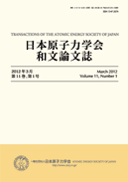Volume 1, Issue 3
Displaying 1-8 of 8 articles from this issue
- |<
- <
- 1
- >
- >|
-
2002Volume 1Issue 3 Pages 253-262
Published: September 05, 2002
Released on J-STAGE: March 08, 2010
Download PDF (6426K) -
2002Volume 1Issue 3 Pages 263-269
Published: September 05, 2002
Released on J-STAGE: January 21, 2010
Download PDF (3078K) -
2002Volume 1Issue 3 Pages 270-281
Published: September 05, 2002
Released on J-STAGE: March 08, 2010
Download PDF (1148K) -
2002Volume 1Issue 3 Pages 282-288
Published: September 05, 2002
Released on J-STAGE: January 21, 2010
Download PDF (6078K) -
2002Volume 1Issue 3 Pages 289-302
Published: September 05, 2002
Released on J-STAGE: January 21, 2010
Download PDF (27777K) -
2002Volume 1Issue 3 Pages 303-311
Published: September 05, 2002
Released on J-STAGE: March 08, 2010
Download PDF (864K) -
2002Volume 1Issue 3 Pages 312-316
Published: September 05, 2002
Released on J-STAGE: January 21, 2010
Download PDF (2834K) -
2002Volume 1Issue 3 Pages 317-319
Published: September 05, 2002
Released on J-STAGE: January 21, 2010
Download PDF (3300K)
- |<
- <
- 1
- >
- >|
